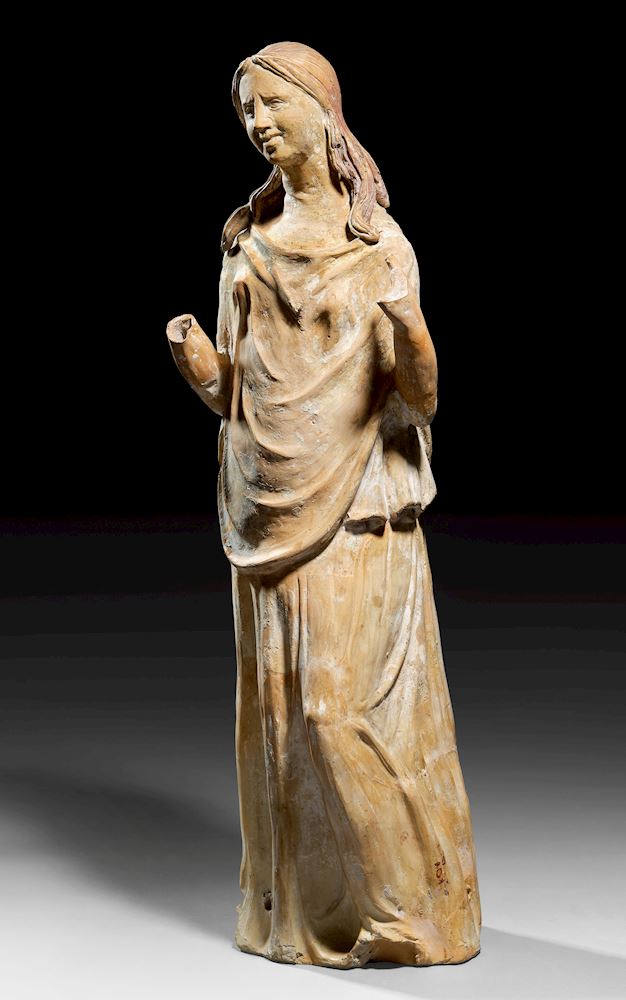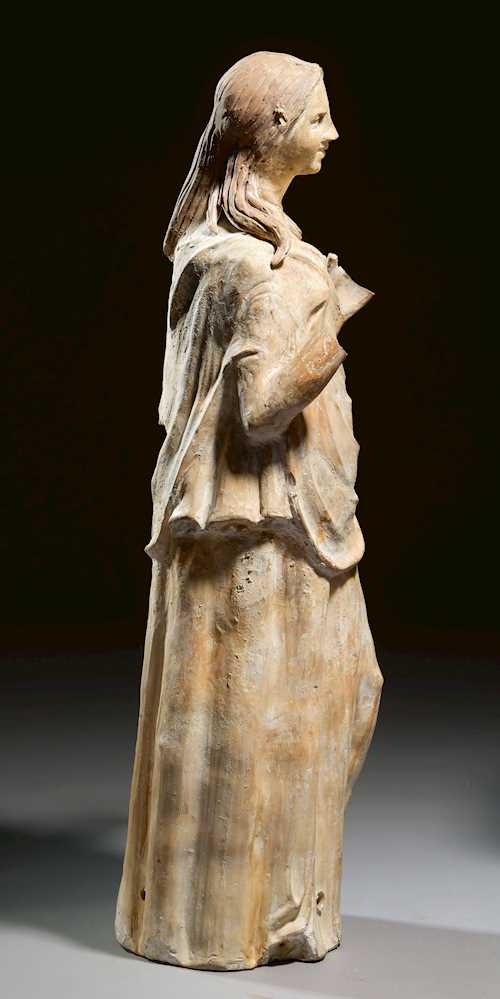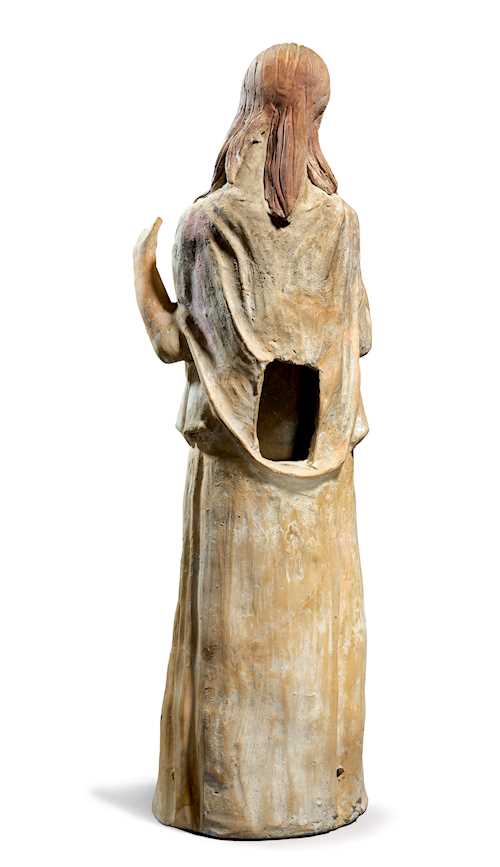
拍品 1006 - A208 家具、瓷器&银器 - Donnerstag, 21. März 2024, 01.30 PM
MOURNER, so-called "Orante".
Probably Canosa, Apulia, 3rd century B.C.
Terracotta, hollowed with traces of engobe. Rectangular opening in the back. Upright, female figure standing slightly in contrapposto, wrapped in a chiton. The arms bent in a gesture of lamentation (left hand incomplete, right forearm incomplete). Long neck, expressive facial features, shoulder-length parted hair.
H 92 cm.
Repaired, assembled from several pieces. Original piercings. Right hand missing, left arm supplemented, hand incomplete. Chips to the foot area.
Provenance:
- From a Ticino collection, 1950/60 (according to Galerie Günther Puhze).
- Probably Swiss art trade, 1981 (reference in: Frederike van der Wielen-van Ommeren, "orantes canosines", in: Genève et l'Italie, Geneva 1999, p. 56, No. 23).
- Galerie Günther Puhze, Basel, November 2013.
These terracotta figures depict women in various gestures of prayer, affection, or mourning, and are therefore titled "orantes" or "pleureuses" in the French literature. The figures were discovered in small groups of four to six pieces each in aristocratic burial chambers in Canosa, Apulia, southern Italy. The Geneva archaeologist Waldemar Deonna was the first to realize the importance of these figures with his publication "Les statues de terre cuite dans l'antiquité" (Paris, 1907/1908). The funerary sculptures were created in the late fourth and early third centuries B.C. They are unusually large compared to most Greek terracotta figures. There are fewer than 50 figures in the world (most of them in museums) that are recognized by scholars as ancient. It is only in recent decades that Canosa figures have attracted increased attention from experts. Violaine Jeammet, curator of Greek, Etruscan and Roman antiquities at the Musée du Louvre, has devoted a great deal of attention to these characteristic mourning women. In her publication "Quelques particularités de la production des pleureuses canosines en terre cuite," she outlines three main groups of Canosinian mourning women based on a technical analysis that essentially reflects the method of manufacture. The variety of clothing (himation, chiton or short or long), hairstyles (braids, parted hairstyle), facial expressions (serious, resolved, sad, etc.) and gestures allow her to make even finer iconographic groupings. Frederike van der Wielen-van Ommeren, in an article from 1999, probably mentions the Mourning Woman on offer, which appeared on the Swiss art market in 1981. She attributes the figure to a group of mourning women with the following characteristics: "Group II, Series 4 short to medium length himation covered by a tunic except under the arms and which forms asymmetrical draperies between the arms; the hair falls in one or three strands" (Cf. Frederike van der Wielen-van Ommeren, "orantes canosines", in: Genève et l'Italie, Geneva 1999, p. 56, No. 23).
Considering the limited production, it is likely that the Canosine mourners were made in the same workshop or at least in closely related workshops. The differences in appearance probably show the handwriting of individual craftsmen. The colored engobe enlivened the figures and brought them to life, so to speak. The exact function of the wailing women in the cult of the dead continues to be debated. The holes, which are visible in the area of the base, also indicate a use as processional statues at funerals, and were made so that the statues could be shouldered through a wooden construction. Inside the tomb, the statues were arranged around the barrow of the dead, where they acted as constant companions to the deceased, ensuring the soul's safe passage into the afterlife through constant prayer and mourning.
Some impressive exhibits are in renowned museums and can be used as comparisons. As far as the gathering or drapery of the garment and the bent arms towards heaven are concerned, the figure on offer can be compared with a group of four from the J. Paul Getty Museum (Inv. No. 85.AD.76.1-4). Proportions, facial expressions, pose and details such as the shoulder-length hair parted in two strands in the middle of a pleureuse in the Louvre in Paris (Inv. No. CA 7500) shows striking similarities to the one on offer.
Bibliography:
- Violaine Jeammet, "Quelques particularités de la production des pleureuses canosines en terre cuite," Revue Archéologique, 2003/2, pp. 255-292.
- Ruth Allen, "Science Reveals New Clues about Mysterious Ancient Sculptures of Mourning Women," The J. Paul Getty Museum, 2019.
- Mollard-Besques IV-I, No. D4116, plate 156a and D4116 plate 156c.
- Frederike van der Wielen-van Ommeren, "orantes canosines," in Angela Kahn-Laginestra (ed.) Genève et l'Italie, Geneva 1999, pp. 44-65.
Provenance:
- From a Ticino collection, 1950/60 (according to Galerie Günther Puhze).
- Probably Swiss art trade, 1981 (reference in: Frederike van der Wielen-van Ommeren, "orantes canosines", in: Genève et l'Italie, Geneva 1999, p. 56, No. 23).
- Galerie Günther Puhze, Basel, November 2013.
These terracotta figures depict women in various gestures of prayer, affection, or mourning, and are therefore titled "orantes" or "pleureuses" in the French literature. The figures were discovered in small groups of four to six pieces each in aristocratic burial chambers in Canosa, Apulia, southern Italy. The Geneva archaeologist Waldemar Deonna was the first to realize the importance of these figures with his publication "Les statues de terre cuite dans l'antiquité" (Paris, 1907/1908). The funerary sculptures were created in the late fourth and early third centuries B.C. They are unusually large compared to most Greek terracotta figures. There are fewer than 50 figures in the world (most of them in museums) that are recognized by scholars as ancient. It is only in recent decades that Canosa figures have attracted increased attention from experts. Violaine Jeammet, curator of Greek, Etruscan and Roman antiquities at the Musée du Louvre, has devoted a great deal of attention to these characteristic mourning women. In her publication "Quelques particularités de la production des pleureuses canosines en terre cuite," she outlines three main groups of Canosinian mourning women based on a technical analysis that essentially reflects the method of manufacture. The variety of clothing (himation, chiton or short or long), hairstyles (braids, parted hairstyle), facial expressions (serious, resolved, sad, etc.) and gestures allow her to make even finer iconographic groupings. Frederike van der Wielen-van Ommeren, in an article from 1999, probably mentions the Mourning Woman on offer, which appeared on the Swiss art market in 1981. She attributes the figure to a group of mourning women with the following characteristics: "Group II, Series 4 short to medium length himation covered by a tunic except under the arms and which forms asymmetrical draperies between the arms; the hair falls in one or three strands" (Cf. Frederike van der Wielen-van Ommeren, "orantes canosines", in: Genève et l'Italie, Geneva 1999, p. 56, No. 23).
Considering the limited production, it is likely that the Canosine mourners were made in the same workshop or at least in closely related workshops. The differences in appearance probably show the handwriting of individual craftsmen. The colored engobe enlivened the figures and brought them to life, so to speak. The exact function of the wailing women in the cult of the dead continues to be debated. The holes, which are visible in the area of the base, also indicate a use as processional statues at funerals, and were made so that the statues could be shouldered through a wooden construction. Inside the tomb, the statues were arranged around the barrow of the dead, where they acted as constant companions to the deceased, ensuring the soul's safe passage into the afterlife through constant prayer and mourning.
Some impressive exhibits are in renowned museums and can be used as comparisons. As far as the gathering or drapery of the garment and the bent arms towards heaven are concerned, the figure on offer can be compared with a group of four from the J. Paul Getty Museum (Inv. No. 85.AD.76.1-4). Proportions, facial expressions, pose and details such as the shoulder-length hair parted in two strands in the middle of a pleureuse in the Louvre in Paris (Inv. No. CA 7500) shows striking similarities to the one on offer.
Bibliography:
- Violaine Jeammet, "Quelques particularités de la production des pleureuses canosines en terre cuite," Revue Archéologique, 2003/2, pp. 255-292.
- Ruth Allen, "Science Reveals New Clues about Mysterious Ancient Sculptures of Mourning Women," The J. Paul Getty Museum, 2019.
- Mollard-Besques IV-I, No. D4116, plate 156a and D4116 plate 156c.
- Frederike van der Wielen-van Ommeren, "orantes canosines," in Angela Kahn-Laginestra (ed.) Genève et l'Italie, Geneva 1999, pp. 44-65.
CHF 20 000 / 30 000 | (€ 20 620 / 30 930)
以瑞士法郎銷售 CHF 12 500 (包含買家佣金)
所有信息随时可能更改。




